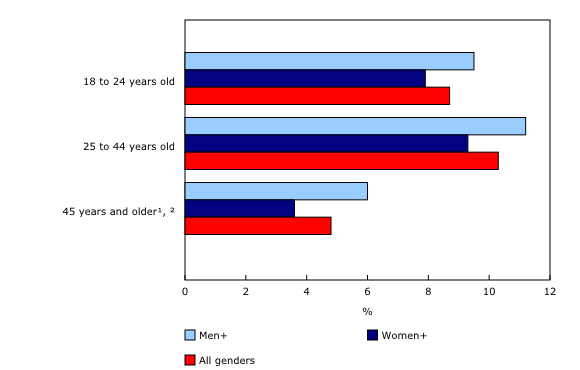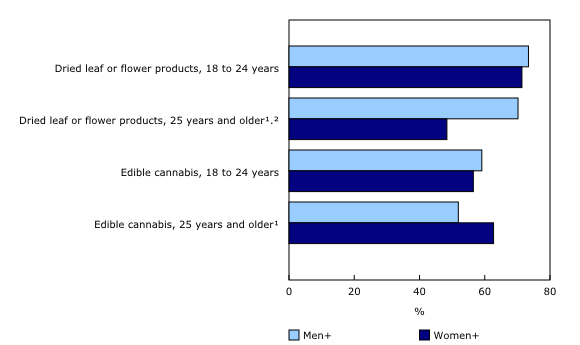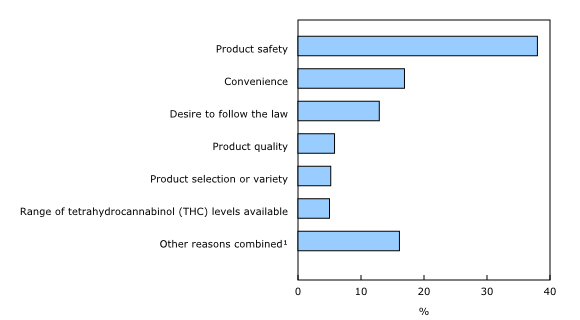National Cannabis Survey, 2023
Released: 2024-03-18
New data show that, in 2023, five years after non-medical cannabis use was legalized, over one-third of younger adults aged 18 to 44 years and one in seven adults aged 45 years and older had used cannabis in the previous 12 months. Cannabis consumers tend to favour products such as dried leaf or flower and edible cannabis, and they often prefer legal cannabis sources because of product safety.
Younger Canadians are twice as likely to use cannabis than older Canadians
In 2023, more than one-third of adults aged 18 to 24 years (38.4%) and 25 to 44 years (34.5%) reported having used cannabis in the previous 12 months, compared with 15.5% of adults aged 45 years and older.
Frequent cannabis use may be a sign of dependence. A recent study found that almost three in four daily cannabis consumers (72.4%) experienced impaired control over their use of cannabis and were at risk for developing cannabis use disorder.
About 1 in 10 adults aged 18 to 24 years (8.7%) and 25 to 44 years (10.3%) reported having used cannabis daily or almost daily in the previous 12 months, compared with 4.8% of adults aged 45 years and older. Among adults aged 45 years and older, men (6.0%) were more likely to use cannabis daily than women (3.6%), while no gender differences were found for adults younger than 45 years.
Different cannabis products for different age groups
The Cannabis Act first allowed legal sales of dried cannabis, fresh cannabis, cannabis oil, cannabis plants and cannabis seeds in October 2018. A year later, it was expanded to include cannabis extracts, edibles and topicals.
Different cannabis products have a range of potency levels, and the method used to consume the product can affect how quickly the effects are felt.
Across all age groups, the two most commonly used product types in the 12 months preceding the survey were dried leaf or flower (62.1%) and cannabis edibles (57.1%).
Several product types (vape pens and cartridges, cannabis extracts and concentrates, cannabis beverages, dried leaf or flower, and edible cannabis) were more commonly used among younger cannabis consumers compared with older consumers. Other product types (cannabis topicals and oral cannabis oils) were more commonly used among older consumers than younger consumers.
For cannabis consumers aged 25 years and older, dried leaf or flower products were used more commonly among men (70.2%) than women (48.4%), and edible cannabis products were more commonly used among women (62.7%) than men (51.9%). These gender differences were not present for young adults aged 18 to 24 years.
Product safety is the most common reason for buying legal cannabis
With more than 3,000 legal cannabis stores in Canada, over two in three cannabis consumers are buying from the legal market. Among those who used cannabis in the 12 months before the survey, just over 7 out of 10 (71.7%) bought exclusively from legal sources.
The main reasons reported for buying cannabis from a legal source were product safety (38.0%), convenience (16.9%) and a desire to follow the law (12.9%).
Did you know we have a mobile app?
Get timely access to data right at your fingertips by downloading the StatsCAN app, available for free on the App Store and on Google Play.
Note to readers
The Cannabis Act (Bill C-45) became law on October 17, 2018. Since cannabis legalization, Statistics Canada has conducted several surveys to measure the social, health and economic impacts of legalized cannabis. The 2023 National Cannabis Survey is the latest contribution to this effort.
Data were collected from July 14 to October 15, 2023, from 2,251 young adults aged 18 to 24 years and 5,185 adults aged 25 years and older. The sample was drawn from people living in the 10 provinces and excluded people living in collective dwellings or people living on reserves.
Cannabis includes marijuana (e.g., weed and pot), hashish, hash oil or any other products made from the cannabis plant. This includes products containing tetrahydrocannabinol (THC), cannabidiol (CBD) or any other cannabinoids (e.g., cannabinol [CBN], cannabigerol [CBG] and delta-8-THC).
The information in this release is self-reported and limited to what the survey respondents were willing to share on an online questionnaire or to an interviewer over the phone. Social desirability and fear of punishment are potential sources of bias, especially for questions that ask respondents to admit to illegal behaviour.
Small sample sizes for some analyses may also have reduced the ability to reach statistical significance. In some cases, age groups were combined to improve statistical power and the stability of the estimates.
Contact information
For more information, or to enquire about the concepts, methods or data quality of this release, contact us (toll-free 1-800-263-1136; 514-283-8300; infostats@statcan.gc.ca) or Media Relations (statcan.mediahotline-ligneinfomedias.statcan@statcan.gc.ca).
- Date modified:



